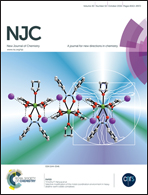Long-chain branching hydrogel with ultrahigh tensibility and high strength by grafting via photo-induced polymerization†
Abstract
A novel long-chain branching (LCB) hydrogel, polyacrylamide grafted from poly(2-acrylamido-2-methylpropanesulfonic acid) via photo-induced polymerization, has been developed with excellent mechanical properties such as ultrahigh tensibility and high strength. Investigations of tensile and compressive properties indicate that the Young's modulus, ultimate strength and strain, toughness, compressive modulus and stress are significantly improved by introduction of LCB. Scanning electron microscopy (SEM) reveals that the amount of embedded micro-network structures in LCB gels is increased with an increase in the length of LCB. The compressive loading–unloading behaviour shows that the area of the hysteresis loop (the dissipated energy) for the first compressive cycle increases with the introduction of LCB and is higher than that for subsequent cycles. The energy dissipation mechanism is demonstrated for a better understanding of LCB gels. Furthermore, rheological measurements are also studied. Dynamic shear measurements show that both the storage modulus and the complex viscosity increase in the presence of LCB.


 Please wait while we load your content...
Please wait while we load your content...